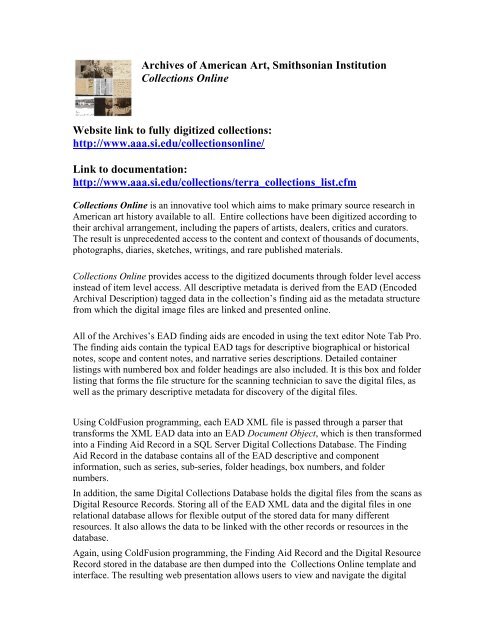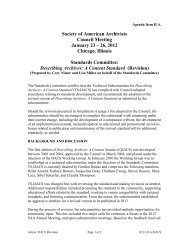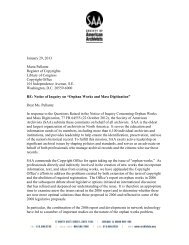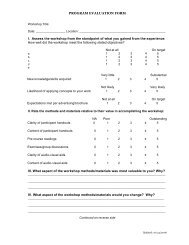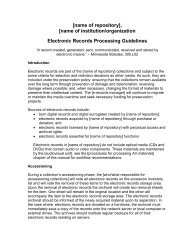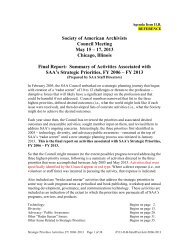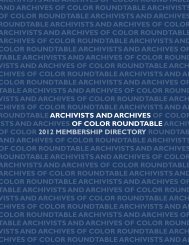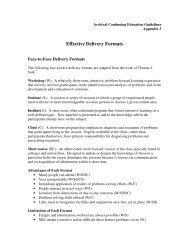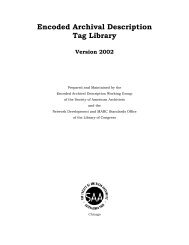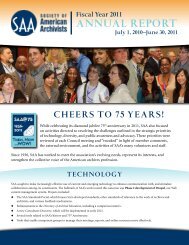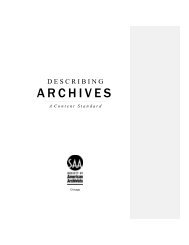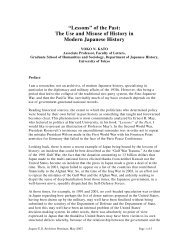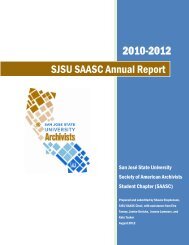Archives Online - Society of American Archivists
Archives Online - Society of American Archivists
Archives Online - Society of American Archivists
You also want an ePaper? Increase the reach of your titles
YUMPU automatically turns print PDFs into web optimized ePapers that Google loves.
<strong>Archives</strong> <strong>of</strong> <strong>American</strong> Art, Smithsonian InstitutionCollections <strong>Online</strong>Website link to fully digitized collections:http://www.aaa.si.edu/collectionsonline/Link to documentation:http://www.aaa.si.edu/collections/terra_collections_list.cfmCollections <strong>Online</strong> is an innovative tool which aims to make primary source research in<strong>American</strong> art history available to all. Entire collections have been digitized according totheir archival arrangement, including the papers <strong>of</strong> artists, dealers, critics and curators.The result is unprecedented access to the content and context <strong>of</strong> thousands <strong>of</strong> documents,photographs, diaries, sketches, writings, and rare published materials.Collections <strong>Online</strong> provides access to the digitized documents through folder level accessinstead <strong>of</strong> item level access. All descriptive metadata is derived from the EAD (EncodedArchival Description) tagged data in the collection’s finding aid as the metadata structurefrom which the digital image files are linked and presented online.All <strong>of</strong> the <strong>Archives</strong>’s EAD finding aids are encoded in using the text editor Note Tab Pro.The finding aids contain the typical EAD tags for descriptive biographical or historicalnotes, scope and content notes, and narrative series descriptions. Detailed containerlistings with numbered box and folder headings are also included. It is this box and folderlisting that forms the file structure for the scanning technician to save the digital files, aswell as the primary descriptive metadata for discovery <strong>of</strong> the digital files.Using ColdFusion programming, each EAD XML file is passed through a parser thattransforms the XML EAD data into an EAD Document Object, which is then transformedinto a Finding Aid Record in a SQL Server Digital Collections Database. The FindingAid Record in the database contains all <strong>of</strong> the EAD descriptive and componentinformation, such as series, sub-series, folder headings, box numbers, and foldernumbers.In addition, the same Digital Collections Database holds the digital files from the scans asDigital Resource Records. Storing all <strong>of</strong> the EAD XML data and the digital files in onerelational database allows for flexible output <strong>of</strong> the stored data for many differentresources. It also allows the data to be linked with the other records or resources in thedatabase.Again, using ColdFusion programming, the Finding Aid Record and the Digital ResourceRecord stored in the database are then dumped into the Collections <strong>Online</strong> template andinterface. The resulting web presentation allows users to view and navigate the digital
files within their archival context and hierarchy.The <strong>Archives</strong> has also developed a fully web based internal workflow that includesimproved methods for storing and updating the EAD finding aids.Future plans include presentation <strong>of</strong> finding aids for collections that haven’t been fullydigitized through an interface that is based on Collections <strong>Online</strong>.For further information about this project, contact:Karen Weiss, Project Director, weissk@si.eduToby Reiter, IT Specialist, reitert@si.eduBarbara Aikens, Chief <strong>of</strong> Collections Processing, aikensb@si.edu


